In this post I have explained how to transmit Internet data through LiFi using a class D amplifier as the transmitter and an ordinary audio amplifier circuit as the receiver.

How Li-Fi Concept Works
If you are wondering how a LiFi concept could be used for transmitting USB data, this article will provide with all the details you required.
We know that a Li-Fi concept is used for transmitting a digital data across a given premise more efficiently than any other means invented so far, especially because the Li-Fi idea allows the user to transmit the data and additionally illuminate the area where it's been installed, so it's like getting two crucial benefits from a single unit.
Remember our age old film projector device? It's probably the oldest known method of using light for transmitting data (picture).
Although we always had other great means of transmitting wireless data such as Wi-Fi technology, RF circuits, etc, using light for this purpose was never imagined simply because lights have been always considered as low-tech units, and thus underestimated, until the day when Mr. Harald Hass discovered this hidden potential of lights (LEDs), and showed the world how LEDs could be actually used for transmitting data in a much efficient way than any other contemporary techniques.
In one of our earlier articles I have explained through an example circuit regarding how to effectively transmit audio signal through a Li-Fi, in this article we'll go a little further and learn how to transmit an USB signal through Li-Fi.
Since LEDs are semiconductors devices these become perfectly compatible for handling digital data without any form of distortions. An LED will replicate and transmit the input content exactly as it was in the original source, and this property make LEDs extremely easy to configure for the intended purpose.
So far we have understood that Li-Fi is a method in which LED is used for transmitting a high frequency content within an enclosed room, which effectively transforms the LED into a wireless transmitter as well as a light producing device.For example Li-Fi concept can be used for transmitting and receiving a music data by using an LED as the light source and also a wireless music transmitter.
However the biggest challenge is to use a Li-Fi circuit for transmitting Internet data using ordinary parts and without involving complex and difficult to get components or MCUs.
A USB connector basically consists of the following wiring details:
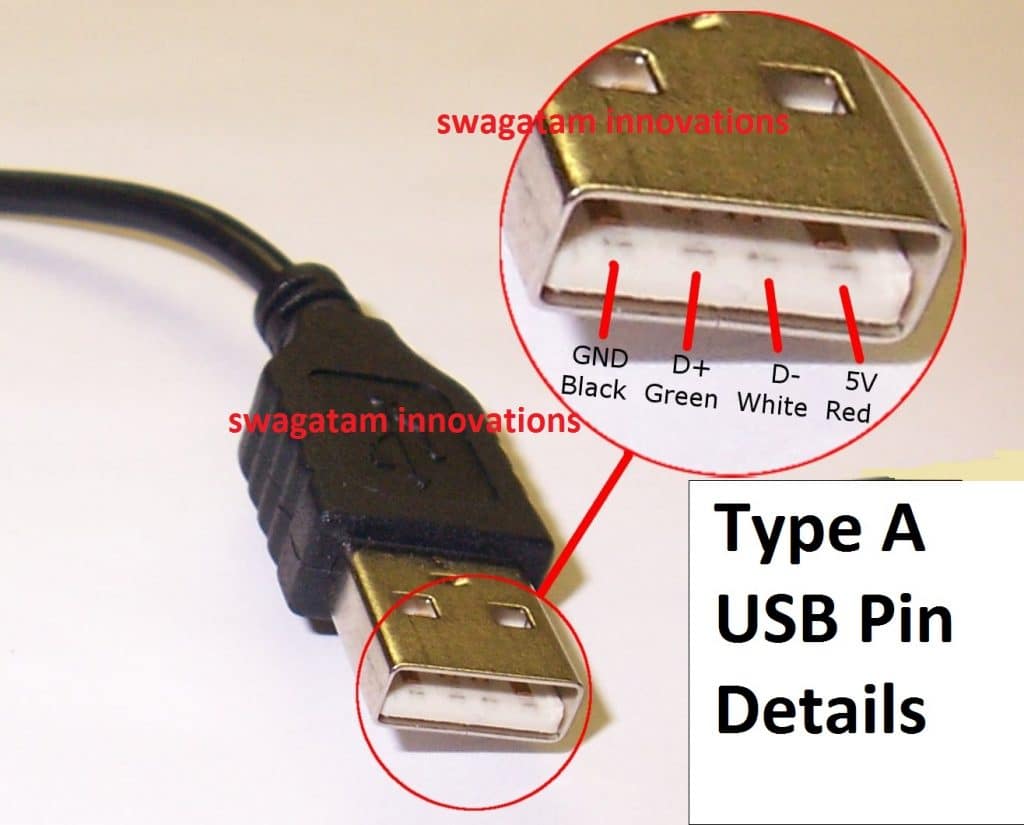
1) +5V
2) Ground
3) +D
4) -D
The +5V and ground are the supply out terminals which are normally used for powering the connected external device.
The +D, and -D are the data communication terminals which produces the complex differential signal across each other in a push-pull manner, meaning the +D is referenced to -D, while the -D signal is referenced to the +D terminals. This is what makes transmitting Internet through LED so confusing and complex.
This forced me to think of an alternative and more efficient design, that could actually transmit an USB internet data through LED Li-Fi circuit, without distorting the actual signal, and by employing ordinary components.
After some thinking I came up with the following circuits which hopefully would enable transmitting internet through LED light.
For the transmitter I decided to use a simple differential amplifier circuit module using IC BD5460, the following image shows the basic layout of this amplifier circuit.
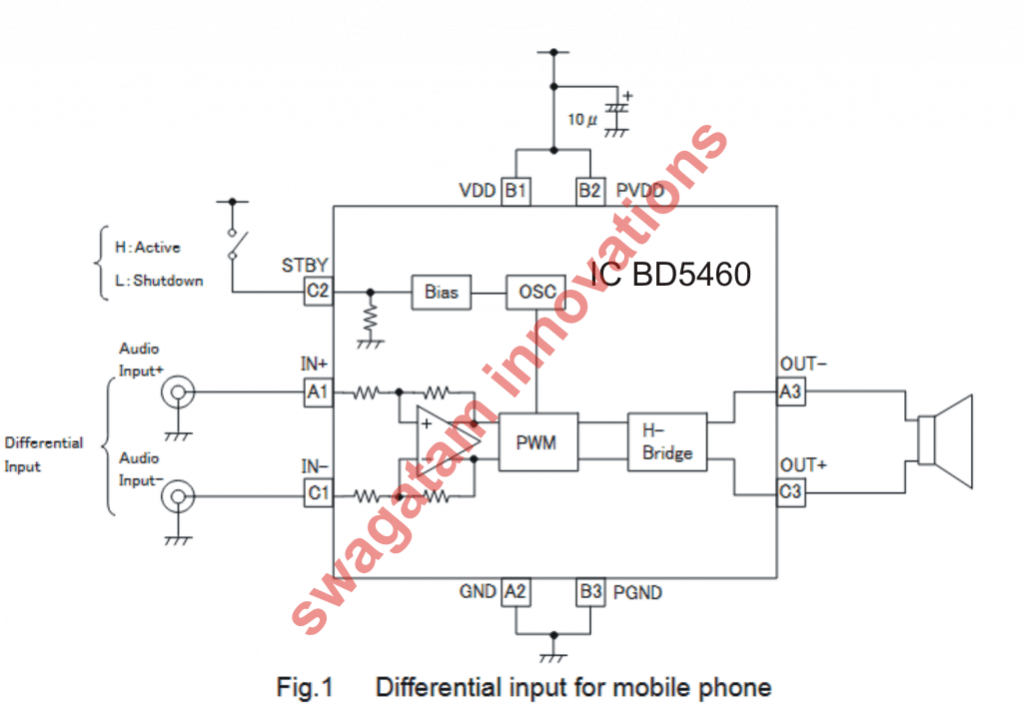
I modified the design into the required Li-Fi transmitter circuit for making it compatible to internet signals, as shown below:
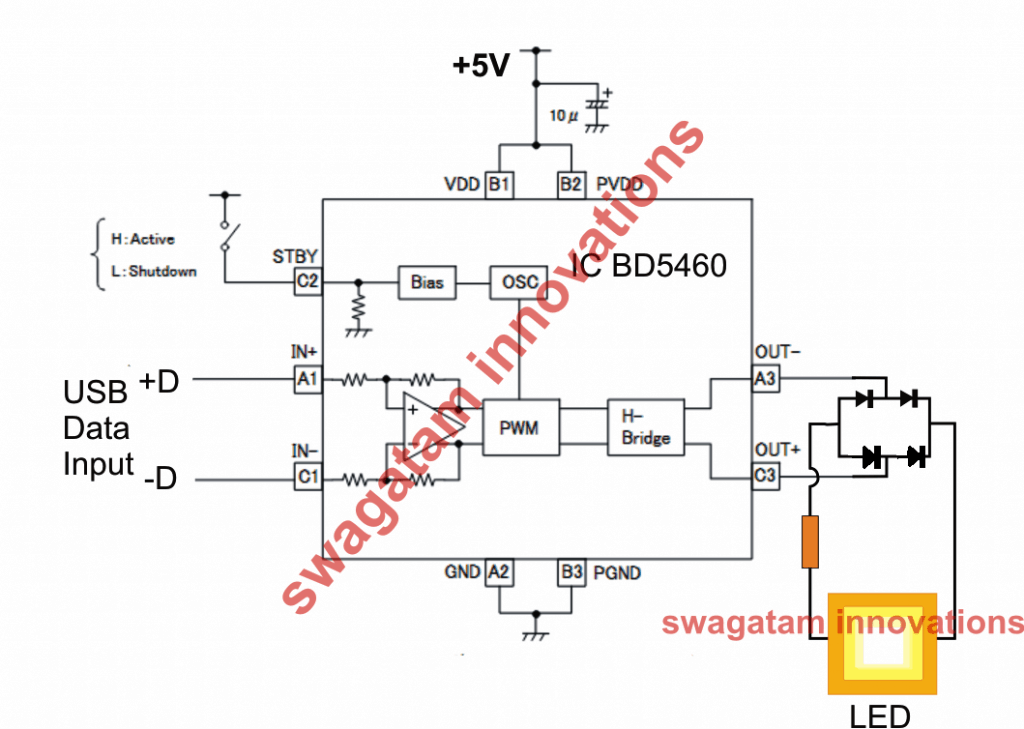
We can see how the differential music input terminals are used for receiving the internet data, while the output is connected to an LED via a bridge rectifier.
Using a bridge rectifier appears to be a smart idea, otherwise it would be simply impossible to transmit the push-pull signals through a LED, since an LED would simply fail to differentiate between these two signals.
By using the bridge we have effectively enabled the LED to recognize both the halves of the USB signal and send it to the receiver without causing any distortions in the original content.
The Receiver Li-Fi Circuit
Now the next challenge for me was to ensure that the rectified pulsating internet data through the LED is correctly decoded back to the original differential form in the receiver section.
This looked difficult however the simulation could be quite easily accomplished by using a dual supply based power amplifier circuit, for example the 100 watt mosfet amplifier already published in this website efficiently fulfilled the intended purpose as shown below:
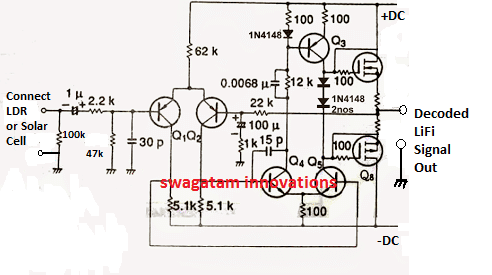
The BJTs and the mosfets can be any general propose rated to work with 12V/1amp supply. However if you want a powerful decoded output you could very well keep the original values for the devices and enjoy a powerful LiFi decoded inernet output.
UPDATE:
In the discussed concept we used a class D amplifier for the LiFi transmitter, however a class D amplifier essentially involves PWM for processing the input, which could be highly undesirable for an internet data to go through.
We do not want to distort or modify the complex Internet data in any manner, therefore a class D amplifier perhaps cannot be applied for an internet LiFi.
As per my assumption we don't need a classD amplifier rather only a BTL amplifier, which does not involve a PWM function, an example design can be witnessed below using the IC TDA7052.
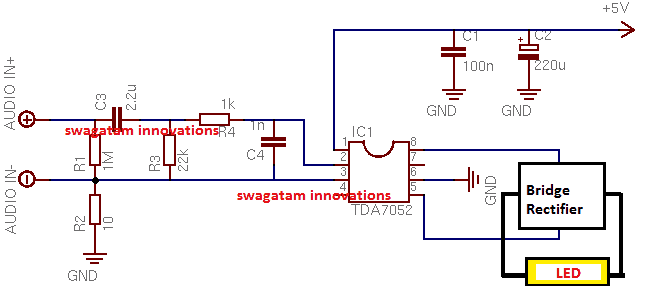
Now this looks perfect, and seems like the Internet data would be transferred to the LED without going through any sort of artificial transformation.
To start with we can go with this 1 watt amplifier circuit as the Li-Fi transmitter and use a 1 watt LED at the output. The idea will confirm whether the proposed Li-Fi transmitter really works or not.
If you have any further doubts regarding this simple yet seemingly working LiFi Internet transmitter circuit you can feel free to express them in the below given comment box.
Adding a Push Pull Stage
In the above diagram everything looks great and it seems the circuit is ready for transmitting the Li-F- data without any issues, however there seems to be a little flaw in the design.
What happens if there's no data at the input? The LED would simply shut down, and that's something totally unacceptable in a Li-Fi concept. Therefore we must somehow make sure that the LED always remains illuminated regardless of the input variations or presence of an input data.
In order to satisfy this condition, we need to introduce a basic LI-FI BJT push pull stage, which was already discussed in our first Li-Fi article.
The following image shows how to do it:

The above design now looks to be a perfect Li-Fi internet transmitter circuit without any flaws.

Have Questions? Please Comment below to Solve your Queries! Comments must be Related to the above Topic!!